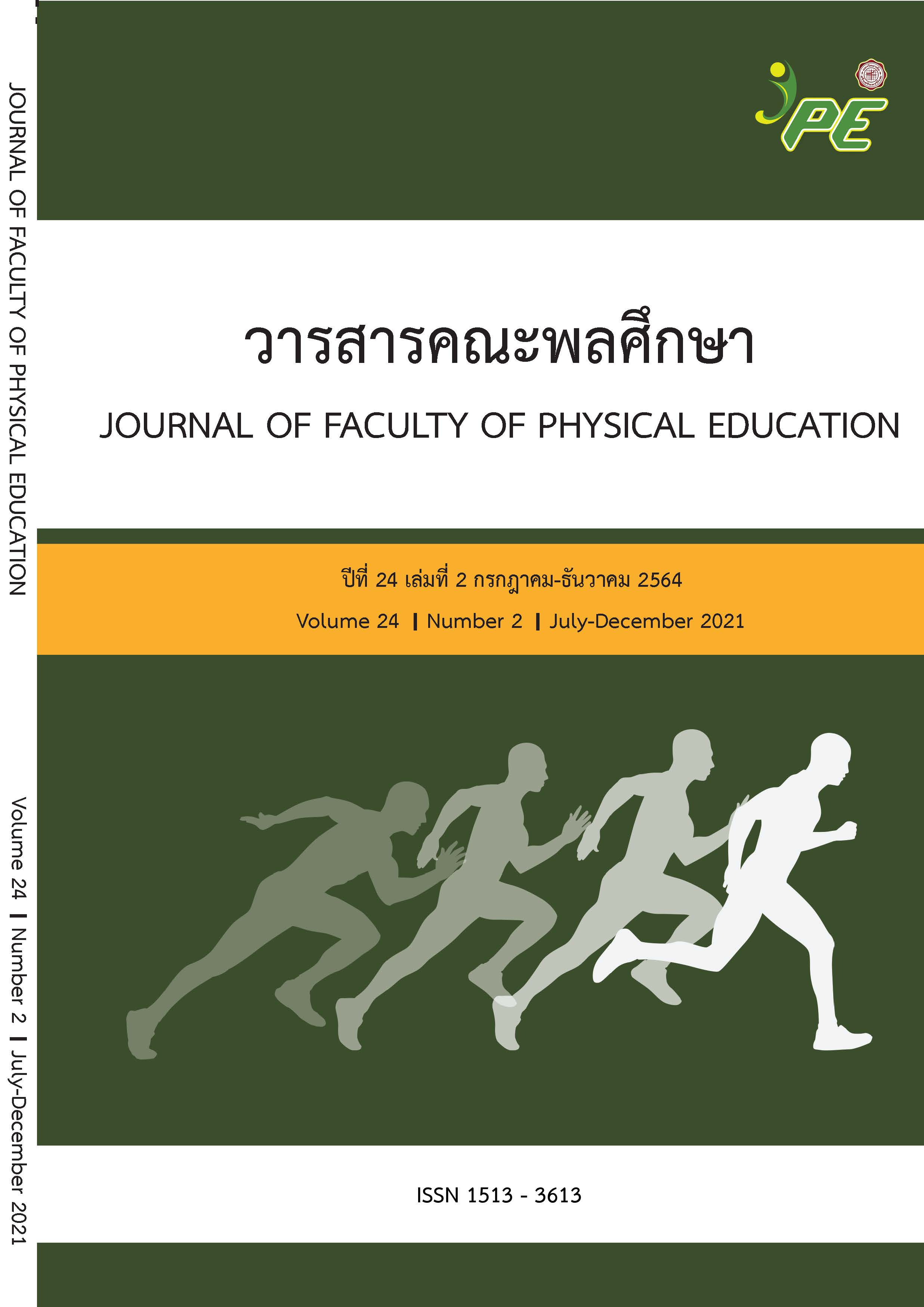THE EFFECT OF AGILITY TRAINING PROGRAM ALONG WITH INCREASING INTENSITY AFFECTING AGILITY AND LEG MUSCLE STRENGTH OF THAI BOXING ATHLETES
Main Article Content
Abstract
Purposes: The research aimed to study and compare effects of agility training program with increasing
intensity affecting speed and leg muscle strength of Thai boxing athletes between Experimental Group and
Control Group.
Research Methodology: It is Quasi Experimental Research. The samples passed the group selection
criteria which were Thai male boxing athletes in developing level aged 18-22 years in Thailand National
Sports University, Phetchabun Campus having Thai boxing competition experiences at least 3 years and
being in practicing period and not being in Thai boxing competition schedule. Purposive random sampling
was implemented at least 14 people dividing into 2 groups with 7 people per each group. The sampling
was from drawing lots dividing into Experimental Group and Control Group practicing for 6 weeks using
Illinois agility test and Back and Leg dynamometer. The data was compared the average of agility and leg
muscle strength. It was found that the data was compared between the control group and the
experimental group were t-test independent, the significance level .05.
Findings: It was found that referring to agility test before and after of experimental group with agility training
program with increasing intensity of Thai boxing athletes, before training the agility was as 17. 1 ± 1. 33
seconds and after 6 weeks of training the agility was as 15.10 ± 1.51 seconds. The agility was better after
6 weeks of training. Besides, before training leg muscle strength test was as 2.163 ± 0.35 Kilograms/body
weight and after training leg muscle strength was as 2. 83 ± 0. 20 Kilograms/body weight. Leg muscle
strength was better after 6 weeks training. It was shown that after 6 weeks training agility and leg muscle
strength were better with Statistical Significance as .05
Conclusion: It was concluded that agility training program with increasing intensity affecting agility and leg
muscle strength could increase agility and leg muscle strength of Thai boxing athletes, Faculty of Education,
Thailand National Sports University, Phetchabun Campus.
Article Details

This work is licensed under a Creative Commons Attribution-NonCommercial-NoDerivatives 4.0 International License.
Any articles and comments This journal is the opinion of the author. The Faculty of Physical Education doesn't always have to agree. Anyone wishing to publish or distribute a message must obtain direct permission from the author.
References
Charuay Kanvongkham. (1986). Exercise of Anatomy and Physiology. Bangkok: University
Srinakharinwirot Physical Education. [in Thai]
Somchai Prasertsiriphan. How to exercise: Health Journal, 14(5) : 1977. [in Thai]
Maleerat Maneekiao. (2001). Effects of s-shape and z-shape running training on agility of rugby football
players. Master of Science Thesis Sports Science, Kasetsart University. [in Thai]
Anan Atchu. (1993). Principles of sports training. Bangkok: Thai Wattana Panich. [in Thai]
Charuay Krabuanrat. (2002). Training and Fitness Enhancement for Soccer Athletes Science Handbook
Sports for Football. Bangkok: New Thai Mitr Printing. [in Thai]
Wipoj Chansem. The Effects of Supplementary Legs Muscle Power Training with Pneumatic
Resistance Combined With Sprint Training on Curve Treadmill on Sprint Times Over Various Distances in
Rugby Football Players. Journal of Sports Science and Health ; 20 (2) : 2019. [in Thai]
Moritani, T., and Devries, H.A. (1979). Neural factors versus hypertrophy in the time
course of muscle strength gain. American Journal of Physical Medicine, 58, 115-130.
Onemai Praphanbundit , Sukanya Charoenwattana, Niromlee Makaje ,Thawichai Khaothin. Changes
in Performance of Professional Thai Boxers After Six-Weeks Training. Faculty of Sports Science, Burapa
University. Faculty of Sports Science, Kasetsart University. Kampheangsean Campus, Nakhon Pathom.
School of Sports Science, Institute of Science, Suranaree University of Technology, Nakhon Ratchsima ;
Journal of Sports Science and Technology Volume ; 19 (1) : 2019. [in Thai]
Sirirat Hiranrat. (1993). Muscle building. in the Sports Science Department of Sports Thailand (Editor),
Physical Fitness Training (page 41-50). Bangkok:Thai Mitr Printing. [in Thai]
Salee Supaporn. (1983). The effect of jumping rope muscle training on the ability to
Long jump. Bangkok : Master's Thesis, Srinakharinwirot University Prasarnmit. [in Thai]
Songsak Phusi-on. (2008). Application of SPSS for data analysis. Research (2nd edition). Kalasin:
Coordinate printing. [in Thai]
Siripanya, S. and Intiraporn, C. (2008). The effect of complex training with combined weight training
and exposive movement on muscular performance in thai female national sepaktakraw athletes. Journal
of Sports Science and Health, 9(2), 10-24. [in Thai]
Charuay Krabuanrat. (2001). Developing athletic capability and developing training plans. In the
supporting documents for the Sports Science Workshop (page 1-7). Chiang Mai: Chiang Mai University.
[in Thai]
Neuman, W. L. (1997). Social research methods: Qualitative and quantitative approaches. Boston:
Allyn & Bacon.
Suttikorn Apanukul. Periodization training for strength. Journal of Sports Science and Health Volume;
(3) : 2019. [in Thai]
Sonthaya Seelamad. (2008). Effects of weight training on physical fitness and body composition of
students. kasetsart university kamphaeng saen campus enrolled in weight training. Bangkok: Research
and Development Institute of Thailand, Kasetsart University. [in Thai]
Prajak Suwanthirakit. (2005). Results of maneuverability training of university male volleyball players.
Rajamangala Technology Lanna Payap campus Master of Science Thesis, Major in Sports Science,
Graduate School, Chiang Mai University. [in Thai]


